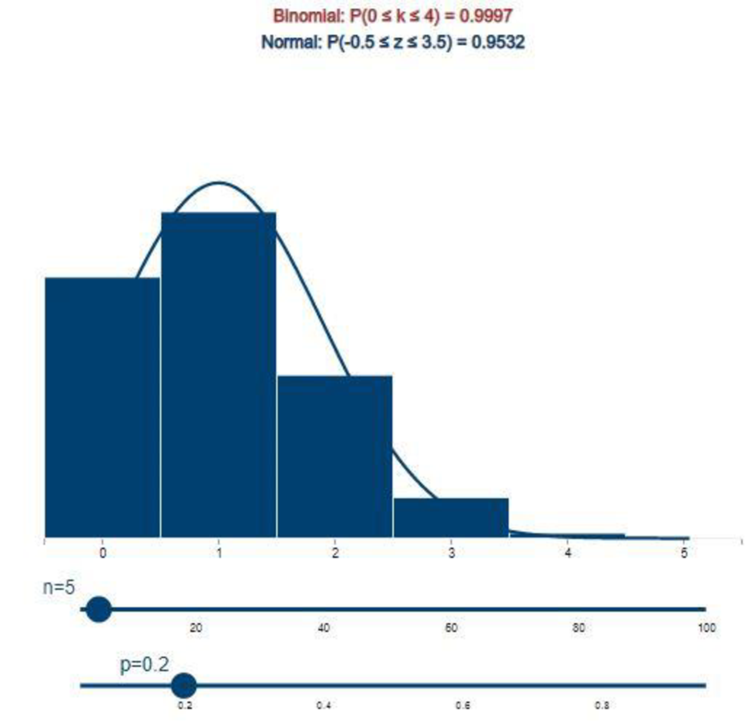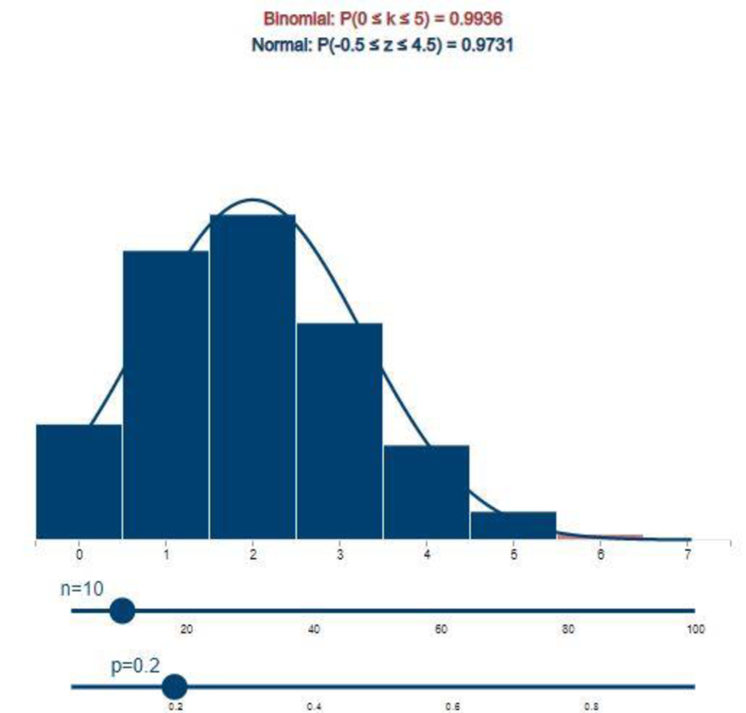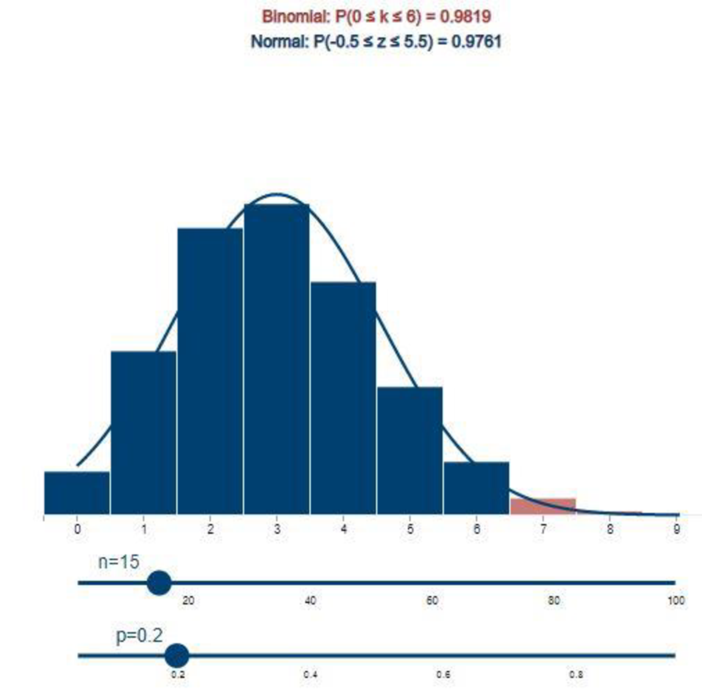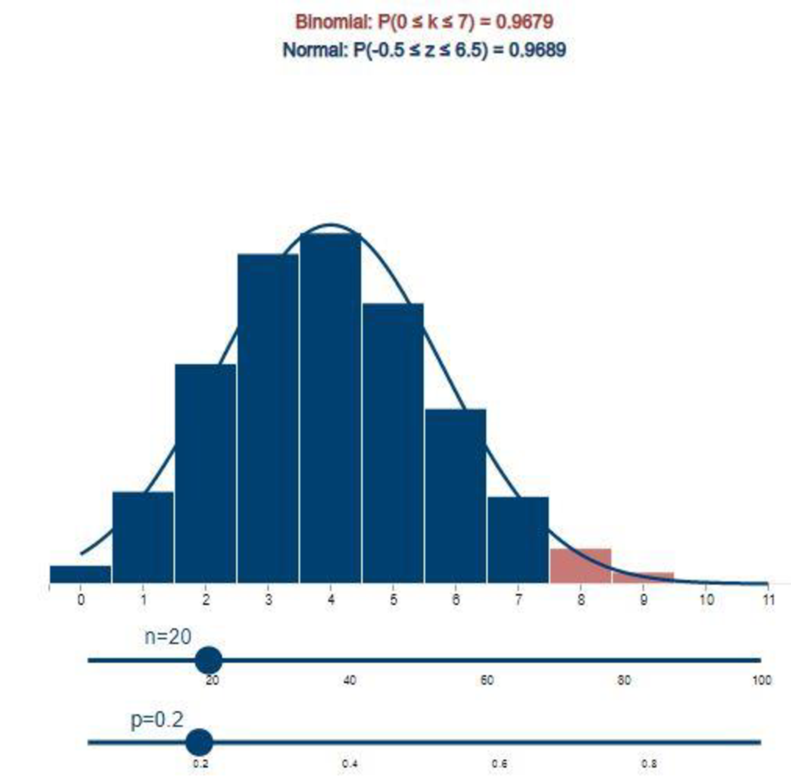
Concept explainers
a.
Find the exact and approximate values of
a.
Answer to Problem 67E
The exact and approximate values of
The exact and approximate values of
The exact and approximate values of
The exact and approximate values of
Explanation of Solution
From the given information, Y follows binomial distribution and
For
Step-by-step procedure to obtain the probability using APPLET:
- Choose Normal approximation to binomial distribution under Applets.
- Set the n value as 5 and p value as 0.20.
- Select the bars 0 and 4.
Output using APPLET is given below:

From the above output, it can be observed that exact and approximate values are 0.9997 and 0.9532, respectively.
Thus, the exact and approximate values of
For
Step-by-step procedure to obtain the probability using APPLET:
- Choose Normal approximation to binomial distribution under Applets.
- Set the n value as 10 and p value as 0.20.
- Select the bars 0 and 5.
Output using APPLET is given below:

From the above output, it can be observed that exact and approximate values are 0.9936 and 0.9731, respectively.
Thus, the exact and approximate values of
For
Step-by-step procedure to obtain the probability using APPLET:
- Choose Normal approximation to binomial distribution under Applets.
- Set the n value as 15 and p value as 0.20.
- Select the bars 0 and 6.
Output using APPLET is given below:

From the above output, it can be observed that exact and approximate values are 0.9819 and 0.9761, respectively.
Thus, the exact and approximate values of
For
Step-by-step procedure to obtain the probability using APPLET:
- Choose Normal approximation to binomial distribution under Applets.
- Set the n value as 20 and p value as 0.20.
- Select the bars 0 and 7.
Output using APPLET is given below:

From the above output, it can be observed that exact and approximate values are 0.9679 and 0.9689, respectively.
Thus, the exact and approximate values of
b.
Give the observation about the shapes of the binomial histograms as the
Give the observation about the differences between the exact and approximate values of
b.
Answer to Problem 67E
The observation is that the shapes of the binomial histograms tend to bell shaped by increasing the sample size.
The difference between the exact and approximate values of
Explanation of Solution
From the histograms in part a, it can be observed that as the sample size increases the binomial histograms become bell shaped.
Thus, the observation is that the shapes of the binomial histograms tend to bell shaped by increasing the sample size.
From the part a, it can be observed that
The exact and approximate values of
The exact and approximate values of
The exact and approximate values of
The exact and approximate values of
From the above results it can be observed that as the sample size increases the difference between the exact and approximate values of
Thus, the difference between the exact and approximate values of
c.
Find the sample size n for the approximation to be adequate.
Check whether this is consistent with that observed in parts (a) and (b).
c.
Answer to Problem 67E
The sample size n for the approximation to be adequate is 36.
The sample size is consistent with that observed in parts (a) and (b).
Explanation of Solution
It is known that, the normal approximate to the binomial approximation is adequate if
From the given information,
Then,
Thus, the sample size n for the approximation to be adequate is 36.
From the parts a and b it can be observed that as the sample size increases the exact and approximate values of
Thus, the sample size is consistent with that observed in parts (a) and (b).
Want to see more full solutions like this?
Chapter 7 Solutions
Mathematical Statistics with Applications
- QUAI6221wA1.docx X + int.com/:w:/r/sites/TertiaryStudents/_layouts/15/Doc.aspx?sourcedoc=%7B2759DFAB-EA5E-4526-9991-9087A973B894%7 26 QUAT6221wA1 Q.1.1.8 One advantage of primary data is that: (1) It is low quality (2) It is irrelevant to the purpose at hand (3) It is time-consuming to collect (4) None of the other options Accessibility Mode Immersive R Q.1.1.9 A sample of fifteen apples is selected from an orchard. We would refer to one of these apples as: (2) ھا (1) A parameter (2) A descriptive statistic (3) A statistical model A sampling unit Q.1.1.10 Categorical data, where the categories do not have implied ranking, is referred to as: (2) Search D (2) 1+ PrtSc Insert Delete F8 F10 F11 F12 Backspace 10 ENG USarrow_forwardepoint.com/:w:/r/sites/TertiaryStudents/_layouts/15/Doc.aspx?sourcedoc=%7B2759DFAB-EA5E-4526-9991-9087A 23;24; 25 R QUAT6221WA1 Accessibility Mode DE 2025 Q.1.1.4 Data obtained from outside an organisation is referred to as: (2) 45 (1) Outside data (2) External data (3) Primary data (4) Secondary data Q.1.1.5 Amongst other disadvantages, which type of data may not be problem-specific and/or may be out of date? W (2) E (1) Ordinal scaled data (2) Ratio scaled data (3) Quantitative, continuous data (4) None of the other options Search F8 F10 PrtSc Insert F11 F12 0 + /1 Backspaarrow_forward/r/sites/TertiaryStudents/_layouts/15/Doc.aspx?sourcedoc=%7B2759DFAB-EA5E-4526-9991-9087A973B894%7D&file=Qu Q.1.1.14 QUAT6221wA1 Accessibility Mode Immersive Reader You are the CFO of a company listed on the Johannesburg Stock Exchange. The annual financial statements published by your company would be viewed by yourself as: (1) External data (2) Internal data (3) Nominal data (4) Secondary data Q.1.1.15 Data relevancy refers to the fact that data selected for analysis must be: (2) Q Search (1) Checked for errors and outliers (2) Obtained online (3) Problem specific (4) Obtained using algorithms U E (2) 100% 高 W ENG A US F10 点 F11 社 F12 PrtSc 11 + Insert Delete Backspacearrow_forward
- A client of a commercial rose grower has been keeping records on the shelf-life of a rose. The client sent the following frequency distribution to the grower. Rose Shelf-Life Days of Shelf-Life Frequency fi 1-5 2 6-10 4 11-15 7 16-20 6 21-25 26-30 5 2 Step 2 of 2: Calculate the population standard deviation for the shelf-life. Round your answer to two decimal places, if necessary.arrow_forwardA market research firm used a sample of individuals to rate the purchase potential of a particular product before and after the individuals saw a new television commercial about the product. The purchase potential ratings were based on a 0 to 10 scale, with higher values indicating a higher purchase potential. The null hypothesis stated that the mean rating "after" would be less than or equal to the mean rating "before." Rejection of this hypothesis would show that the commercial improved the mean purchase potential rating. Use = .05 and the following data to test the hypothesis and comment on the value of the commercial. Purchase Rating Purchase Rating Individual After Before Individual After Before 1 6 5 5 3 5 2 6 4 6 9 8 3 7 7 7 7 5 4 4 3 8 6 6 What are the hypotheses?H0: d Ha: d Compute (to 3 decimals).Compute sd (to 1 decimal). What is the p-value?The p-value is What is your decision?arrow_forwardWhy would you use a histograph or bar graph? Which would be better and why for the data shown.arrow_forward
- Please help me with this question on statisticsarrow_forwardPlease help me with this statistics questionarrow_forwardPlease help me with the following statistics questionFor question (e), the options are:Assuming that the null hypothesis is (false/true), the probability of (other populations of 150/other samples of 150/equal to/more data/greater than) will result in (stronger evidence against the null hypothesis than the current data/stronger evidence in support of the null hypothesis than the current data/rejecting the null hypothesis/failing to reject the null hypothesis) is __.arrow_forward
- Please help me with the following question on statisticsFor question (e), the drop down options are: (From this data/The census/From this population of data), one can infer that the mean/average octane rating is (less than/equal to/greater than) __. (use one decimal in your answer).arrow_forwardHelp me on the following question on statisticsarrow_forward3. [15] The joint PDF of RVS X and Y is given by fx.x(x,y) = { x) = { c(x + { c(x+y³), 0, 0≤x≤ 1,0≤ y ≤1 otherwise where c is a constant. (a) Find the value of c. (b) Find P(0 ≤ X ≤,arrow_forwardarrow_back_iosSEE MORE QUESTIONSarrow_forward_ios
 Glencoe Algebra 1, Student Edition, 9780079039897...AlgebraISBN:9780079039897Author:CarterPublisher:McGraw Hill
Glencoe Algebra 1, Student Edition, 9780079039897...AlgebraISBN:9780079039897Author:CarterPublisher:McGraw Hill
